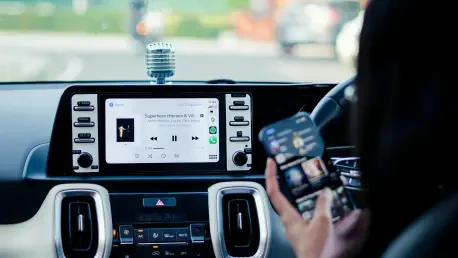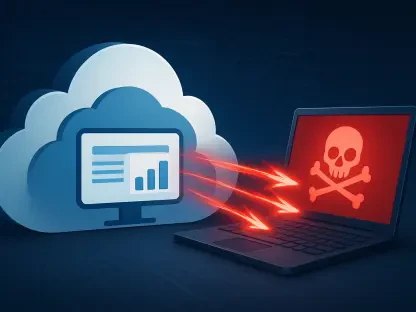What happens when the technology meant to streamline your drive becomes a backdoor for hackers? Picture this: you’re cruising down the highway, phone synced to your car’s infotainment system, completely unaware that a silent cyberattack could be tracking your every move or listening to your private conversations through the vehicle’s microphone. Apple CarPlay, a feature in millions of vehicles worldwide, harbors a critical vulnerability that allows remote code execution without any user interaction. Despite a fix being available, most cars remain exposed, raising urgent questions about safety and accountability in the connected car era.
The Silent Risk in Your Dashboard
This isn’t just a minor glitch; it’s a zero-click vulnerability, identified as CVE-2025-24132 with a severity score of 6.5, that could grant attackers root-level access to a vehicle’s infotainment system. Discovered earlier this year, the flaw enables malicious actors to infiltrate systems through common connection points like Bluetooth or Wi-Fi, often without any need for user permission. The implications are chilling—personal data could be stolen, or distractions could be engineered, potentially endangering lives on the road.
The slow response to this issue amplifies the concern. While a patch was released by Apple on March 31, the majority of car manufacturers have yet to implement it, leaving countless drivers vulnerable. This gap between discovery and action highlights a troubling disconnect in an industry where consumer safety should be paramount, setting the stage for a deeper exploration of why this flaw persists.
Decoding the Vulnerability
At the heart of this issue lies a flaw in Apple’s iAP2 protocol, which governs communication between devices and in-vehicle systems. This protocol’s one-way authentication process verifies the car’s system but fails to authenticate the connecting device, allowing attackers to impersonate legitimate hardware and execute harmful commands. Such a design oversight creates a wide-open door for exploitation, especially in vehicles with outdated security settings.
The methods of attack are alarmingly accessible. Hackers can exploit the vulnerability via USB, Wi-Fi, or Bluetooth, with the latter often using insecure “Just Works” pairing that skips user verification. Compounding the problem, many vehicles—particularly older models—rely on default or easily guessable Wi-Fi passwords, making unauthorized access a disturbingly simple task for determined cybercriminals.
Root-level access, once gained, opens up a range of threats. Attackers could track a driver’s location, eavesdrop on conversations through the car’s microphone, or introduce dangerous distractions via the dashboard display. While it remains unclear if this access extends to critical systems like braking, the potential for escalation keeps experts on edge, underscoring the urgency of addressing this flaw.
Industry Delays and Expert Frustration
Cybersecurity professionals are sounding the alarm over the automotive sector’s sluggish response. Uri Katz from Oligo Security, who disclosed the vulnerability in April, criticized the industry, stating, “The delay between a patch’s release and its application in vehicles is unacceptable. Standardization and over-the-air updates must become the norm.” This frustration reflects a broader sentiment that car manufacturers are unprepared for the rapid evolution of cyber threats.
Despite the availability of a fix for several months, reports show that only a handful of vendors have acted, while major automakers lag behind. This inaction isn’t solely a technical issue; it points to systemic challenges, including fragmented supply chains and a lack of urgency in prioritizing consumer safety over logistical hurdles. The result is millions of vehicles still at risk on roads across the globe.
The contrast between tech and automotive industries is stark. While smartphones often receive seamless updates, many cars require manual patches or dealership visits, creating barriers to timely protection. This outdated approach leaves drivers exposed, fueling calls for regulatory oversight to enforce faster and more efficient security measures.
Real-World Implications for Drivers
Consider the case of a busy professional relying on CarPlay for navigation and hands-free calls during a daily commute. Unbeknownst to them, a hacker exploiting this vulnerability could access their location data, potentially using it for stalking or other malicious purposes. Such scenarios transform a convenient feature into a personal security nightmare, affecting not just privacy but peace of mind.
Beyond individual risks, the broader impact on public safety cannot be ignored. If an attacker manipulates the infotainment system to display distracting content or disable key features at a critical moment, the consequences could be catastrophic. These possibilities, though not yet confirmed in scope, highlight why this vulnerability is more than a technical footnote—it’s a pressing concern for every road user.
Statistics paint a grim picture of the scale. With over 200 million vehicles worldwide equipped with CarPlay as of this year, and many lacking updated software, the pool of potential targets is vast. This widespread exposure demands immediate attention, yet the automotive industry’s response remains frustratingly piecemeal, leaving drivers to bear the burden of uncertainty.
Steps to Protect Your Vehicle
While systemic change is essential, individual actions can offer some defense against this threat. Start by contacting your car manufacturer or dealership to check for available software updates for the infotainment system. Even if updates aren’t delivered over-the-air, a manual patch at a service center could significantly reduce your risk of exploitation.
Strengthening connection security is another practical measure. Disable Bluetooth when it’s not in use and avoid relying on default Wi-Fi passwords for the car’s system. Customizing these settings creates a basic shield against unauthorized access, though it’s not a complete solution in the face of sophisticated attacks.
Finally, advocacy plays a vital role. Drivers can push for accountability by voicing concerns to manufacturers and supporting initiatives for mandatory security standards in connected vehicles. Staying informed about cybersecurity developments related to in-car systems also empowers users to act swiftly when new vulnerabilities or fixes emerge, bridging the gap until industry-wide reforms take hold.
Reflecting on a Path Forward
Looking back, the journey to address this Apple CarPlay vulnerability revealed a troubling lag between technological innovation and security readiness in the automotive world. The months of delay in implementing a critical patch exposed millions to risks that could have been mitigated with swifter action. It became evident that the industry struggled to keep pace with cyber threats, often prioritizing convenience over safety.
Moving ahead, the focus shifted toward actionable solutions. Over-the-air update standardization emerged as a key demand, promising to streamline patch delivery and reduce exposure windows. Regulatory frameworks also gained traction as a means to enforce accountability, ensuring manufacturers treated cybersecurity as a core responsibility rather than an afterthought.
Ultimately, the path forward rested on collaboration—between tech giants, automakers, and policymakers—to build a resilient ecosystem for connected vehicles. By learning from these delays, stakeholders aimed to forge a future where dashboard technology enhanced safety without inviting unseen dangers, turning a moment of vulnerability into a catalyst for lasting change.









